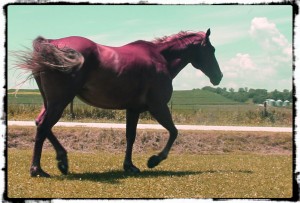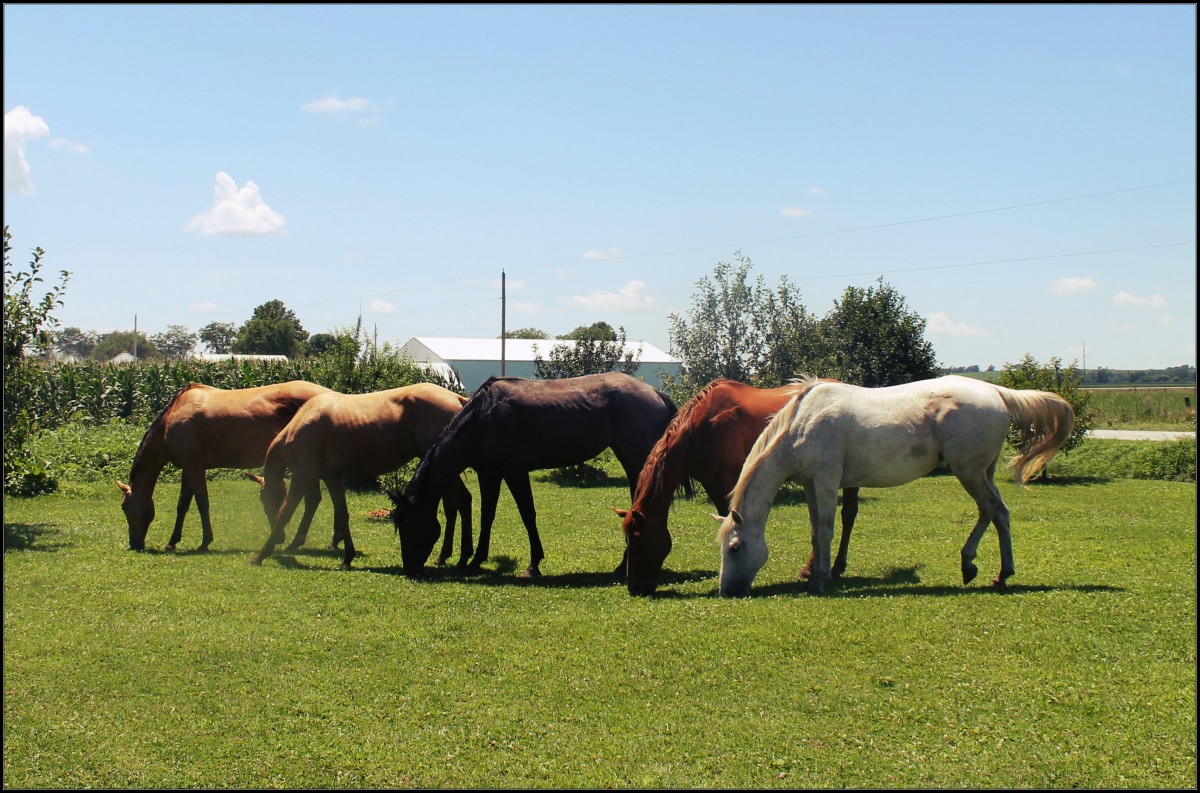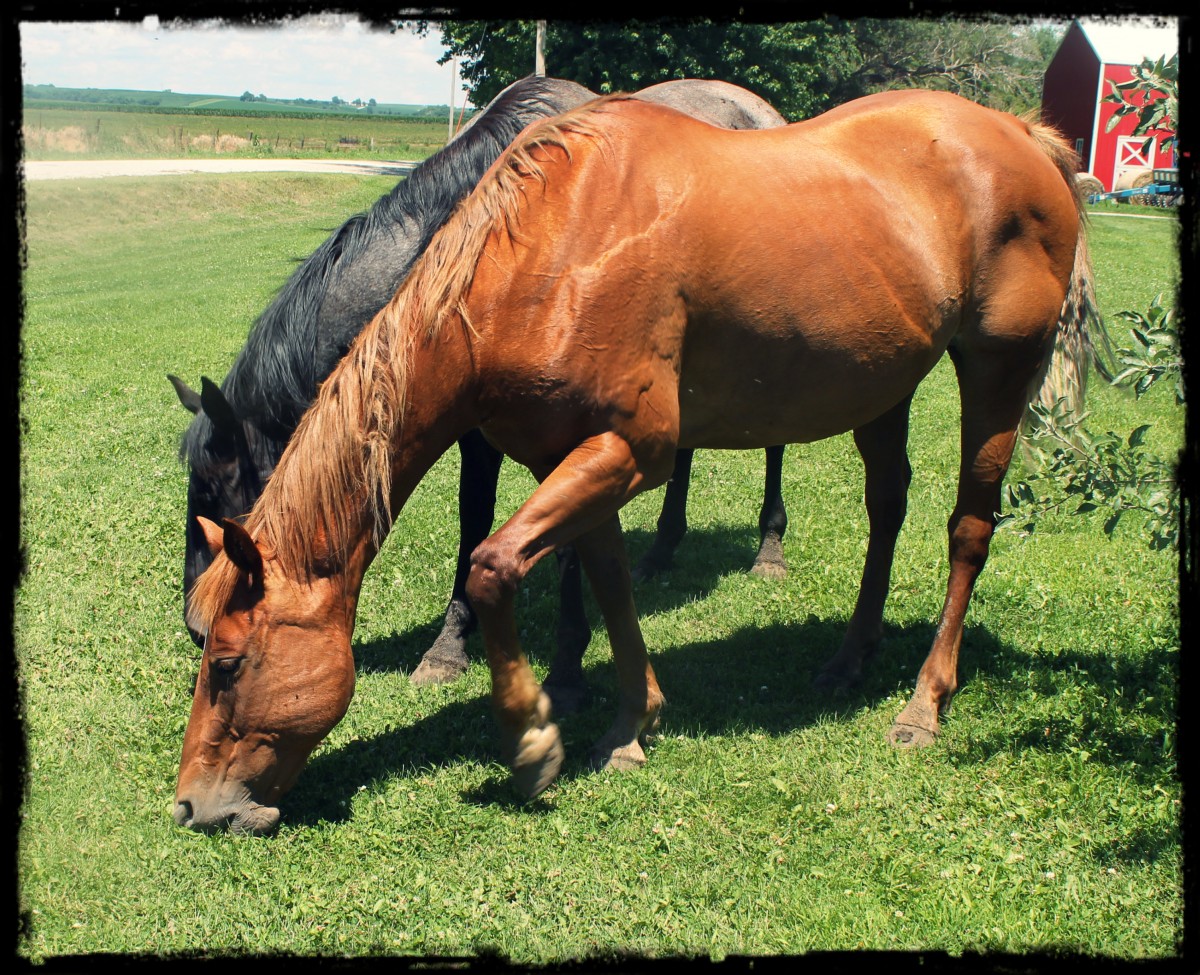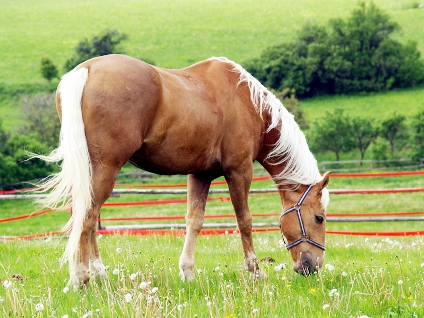 We spent last Saturday, as we do most weekends, out at the farm. The horses are turned out to graze the green grass in the farmyard while my husband and I work in the garden and our kids play with the kittens and ride bikes and such. We were getting along well and having an enjoyable afternoon until I looked over at the group of horses and noticed Daisy just standing there, not eating. I immediately thought, “She’s colicking.” And I turned out to be right.
We spent last Saturday, as we do most weekends, out at the farm. The horses are turned out to graze the green grass in the farmyard while my husband and I work in the garden and our kids play with the kittens and ride bikes and such. We were getting along well and having an enjoyable afternoon until I looked over at the group of horses and noticed Daisy just standing there, not eating. I immediately thought, “She’s colicking.” And I turned out to be right.
See, our horses live in a corral that runs down to a creek bed and along the edge of a cornfield. It’s not a big enough area to keep grass growing, with five horses in it, so we feed hay all year around and turn them out in the yard to eat, or else in an electric fenced area for daytime grazing whenever we can. But on this particular Saturday, we had not gone out in the morning to feed them, so when they were turned out in the yard, they rushed out to eat and gobbled up grass as quickly as they could. Knowing these horses, they will eat continuously without pausing for at least four hours, and usually even longer, before they are looking for something else to do, or want to go stand in the shade or even get a drink. So seeing Daisy stand without eating was my first clue that something was wrong.
The next symptom she showed was laying down and rolling. Every article I’ve ever read on colic says you shouldn’t let the horse roll because they can twist their intestines and they will die from it. I called to my husband who was digging potatoes in the garden, and told him that Daisy was colicking and trying to roll. He immediately went and got her halter and made her walk slowly around the barnyard. We have also read that you should not lead the horse for hours and tire the horse out, so he would let Daisy stand as long as she did not attempt to lie down and roll. We could tell by the way she was standing that she was in pain. She would put her hind legs wide out behind, and stand with her head down, with wrinkles in the skin of her nose.
We have seen our horses do this a few times before, and after walking them awhile, they seem to get over it and commence grazing and though we checked on them a few times later in the day, they did not require any other treatment. But this time, Daisy was not getting better. Chris led her all around, trying to keep her from lying down, but she would almost drop in mid-stride, and he would have to pull her up to keep her from rolling. So she was in a lot of pain. The other horses grazed on happily, oblivious to her condition.
This had been going on for over an hour, and so Chris told me to call the vet. I called Doc Boucher’s office, and his wife said she would see if he could come out to the farm right away. He arrived in less than twenty minutes, and agreed that Daisy appeared to be colicking, but that an aneurism can mimick the signs of colic in a horse, and if she was having an aneurism she would die from it. He gave her an IV of banamine, which he said was not only for pain, but also for inflammation of the colon and digestive tract. He said to give her about ten minutes and we would be able to tell if it was colic (the banamine would help her feel better), or if it was an aneurism she would show no sign of improvement.
The vet also said sometimes a horse can be so full of parasites that they will have an aneurism and appear to be colicking, but will just die from it. We were pretty certain that it wasn’t caused by parasites, since we have our horses on a regular deworming schedule. But it was scary to consider it, just the same.
Within ten minutes, we could see signs of improvement in Daisy. She would look around more, taking more interest in where the other horses were, and started to nibble the grass at her feet, which we prevented her from eating any, but still noted that she was perking up a little. Doc Boucher said to put her in a pen with no feed, just water, and leave her there overnight. Chris went out and checked on her a few times that evening, and said that other than looking annoyed with us for penning her up separately, Daisy seemed to be doing well.
The next morning, Chris turned her out with the others, and he said she trotted right to the hay feeder and went to eating. So she was fine. The vet had left a tube of Banamine in paste form, which he said to give her if she was still sick in the morning, but we didn’t have to use it thankfully. My synopsis of the whole event was that horses digestive systems are designed for them to graze continuously at a slow pace throughout the day, and when Daisy was turned loose in the yard of green grass on an empty stomach, she gobbled it so fast that it caused a blockage in her intestines, which gave her a stomach ache and could have killed her if the blockage hadn’t dissolved.
So I wanted to share the story of our scary colic episode, in hopes that it will help inform other horse owners about colic, and how to proceed if their horse shows the same signs. Here are a few things you should know:
Colic is the number one cause of death in horses. The term colic usually means the horse is suffering from pain in the abdomen, and will evidence this pain by rolling, lying down, kicking or biting at its sides or stomach, not eating as normal, and showing signs of discomfort and pain. Colic is typically a blockage in the digestive tract of a horse, caused by something the horse ate.
Types of colic:
- ideopathic—the cause of colic cannot be detected
- impaction—colic caused by an accumulation of sand, dirt, feed, or other indigestible material that creates a blockage in the horse’s intestine
- gas—excess fluid or gas often caused by fermentation of food in the intestines that build up pressure or inflammation
- non-ideopathic—the cause of the colic is known
- gastric rupture—relatively rare, a rupture can occur when an impaction reaches the stomach or gas buildup causes the stomach to dilate
- enteritis—inflammation of the intestine, caused by infection, virus, or bacteria
- strangulation—one of the most lethal forms of equine colic, when a twist in the colon or small intestine of a horse cuts off the blood supply
- intussusception–most often caused by tapeworms or other parasites, this is a very dangerous form of colic where the intestine slides like a telescope within a portion of itself
The best way to prevent colic in horses is to monitor their diet and keep a close watch on horses when you do have to change their diet. Horses that get too much feed too fast can be at risk for colic. Feeds that are high in carbohydrates or hard to digest can cause colic. Horses are designed to graze for 18 hours per day (as in the wild), and it is better to feed many small meals throughout the day as opposed to one feeding. A regular diet that does not change in quality or quantity is recommended.
If your horse does begin to exhibit signs of colic, keep the horse from lying down to roll by leading it slowly. Do not allow the horse to eat. Call your vet as soon as possible and describe the horse’s symptoms in detail. Listen to the sides of the horse’s belly to hear if there are normal sounds of digestion and sporadic rumbling (silence for long periods of time can indicate blockage).
I am very thankful that Daisy came through her episode with no lasting effects, and that we were there when it happened and could quickly get her the care she needed. 

